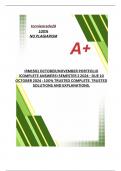, QUESTION 1 Discuss empirical research and its components and provide
examples where necessary. (15 marks)
Empirical research refers to the process of systematically collecting and analyzing data that is
based on direct or indirect observation or experiences, rather than theory or belief. This type of
research uses measurable evidence to produce verifiable findings, ensuring that conclusions are
grounded in real-world data. Empirical research is crucial in fields like social sciences,
education, medicine, and natural sciences.
Components of Empirical Research
1. Research Problem/Question
o This is the foundation of empirical research, where the researcher identifies a
specific issue, question, or hypothesis to investigate. It should be clear, concise,
and researchable through observation or experimentation.
o Example: "Does early reading intervention improve literacy skills in Grade 3
learners?"
2. Literature Review
o A critical analysis of previous studies related to the research problem. The
literature review provides context, identifies gaps in existing research, and
justifies the need for the current study.
o Example: A review of studies examining the effects of early reading intervention
in primary schools.
3. Hypothesis or Research Objectives
o A hypothesis is a testable statement predicting the relationship between variables.
In some cases, researchers may have specific objectives if the research is
exploratory rather than testing a hypothesis.
o Example: "Early reading intervention will lead to improved literacy scores
among Grade 3 learners."
4. Research Design and Methodology
o This refers to the approach the researcher uses to gather data. It includes the type
of study (e.g., qualitative, quantitative, or mixed methods), the tools used for data
collection (surveys, interviews, experiments), and the overall strategy for
gathering and analyzing data.
Quantitative Research: Involves numerical data and statistical analysis
(e.g., surveys, experiments).
Qualitative Research: Focuses on understanding behaviors, experiences,
or social contexts (e.g., interviews, case studies).
Mixed Methods: Combines both qualitative and quantitative techniques.
o Example: A quantitative study that uses standardized literacy tests to measure
improvement in reading skills after an intervention.
5. Sampling
o Researchers define the population and the sample from which data will be
collected. The sample size and selection criteria are important for ensuring the
study’s validity.





